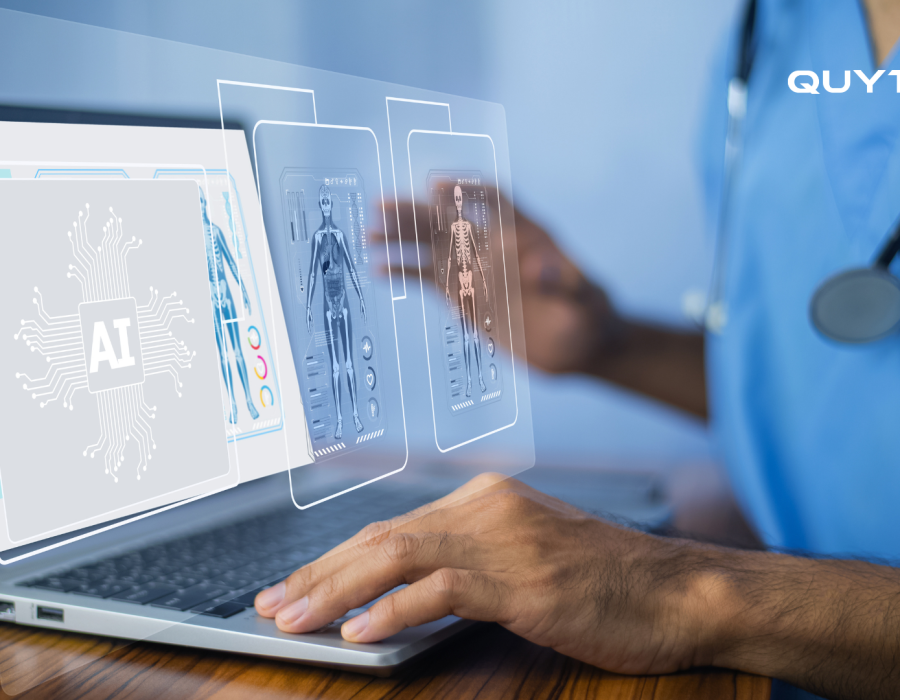Artificial Intelligence (AI) and Machine Learning (ML) are transforming various industries, and healthcare is no exception. In healthcare app development, these technologies are revolutionizing the way diagnoses are made, significantly enhancing diagnostic accuracy and patient care.
This blog will explore the role of AI and ML in improving diagnostic capabilities in healthcare apps and provide examples of successful applications utilizing these technologies, with a focus on healthcare software development.
The Role of AI and Machine Learning in Healthcare Apps
1. Enhanced Diagnostic Accuracy
AI and ML algorithms analyze vast amounts of medical data to identify patterns and correlations that may not be apparent to human clinicians. This capability leads to more accurate and timely diagnoses.
Examples:
- Image Recognition: AI-powered image recognition tools can analyze medical images such as X-rays, MRIs, and CT scans to detect abnormalities with high precision. These tools assist radiologists in identifying conditions like tumors, fractures, and infections.
- Symptom Checkers: AI-driven symptom checker apps can process user-reported symptoms and medical history to suggest potential diagnoses, helping users understand their conditions before consulting a healthcare professional.
2. Predictive Analytics
ML algorithms can predict the likelihood of diseases based on historical data and patient profiles, enabling early intervention and preventive care.
Examples:
- Predictive Models: Predictive models in healthcare apps can assess a patient’s risk of developing chronic conditions such as diabetes, hypertension, and heart disease. By analyzing lifestyle factors, genetic information, and medical history, these models provide valuable insights for personalized preventive measures.
- Real-Time Monitoring: Wearable devices integrated with AI can continuously monitor vital signs and alert healthcare providers to potential health issues, facilitating early diagnosis and treatment.
3. Personalized Treatment Plans
AI and ML enable the creation of personalized treatment plans by analyzing individual patient data, including genetic information, lifestyle choices, and responses to previous treatments.
Examples:
- Genomic Data Analysis: AI algorithms can analyze genomic data to identify genetic mutations and variations that influence disease susceptibility and drug response. This information assists in creating customized treatment plans for patients.
- Adaptive Learning Systems: Adaptive learning systems in healthcare apps use patient data to continuously refine and optimize treatment plans, ensuring the most effective and personalized care.
Successful Healthcare Apps Utilizing AI and Machine Learning
1. Ada Health
Overview: Ada Health is an AI-powered app that acts as a personal health companion. It helps users understand their symptoms and provides potential diagnoses and recommendations for further action.
Features:
- Symptom Assessment: Users can input their symptoms, and Ada’s AI algorithm analyzes them to suggest possible conditions.
- Personal Health Record: Ada stores user data securely, allowing for personalized assessments based on medical history.
- Integration with Healthcare Providers: Ada connects users with healthcare professionals for further consultation and diagnosis.
2. SkinVision
Overview: SkinVision is an AI-driven app designed to detect early signs of skin cancer. Users can take photos of their skin lesions, and the app’s AI algorithm analyzes the images for potential signs of skin cancer.
Features:
- Image Analysis: The app uses deep learning algorithms to evaluate skin lesions and provide a risk assessment.
- Personalized Advice: Based on the analysis, SkinVision offers personalized advice and recommendations for further action.
- Follow-Up Reminders: The app sends reminders for regular skin checks, promoting proactive skin health management.
3. Zebra Medical Vision
Overview: Zebra Medical Vision provides AI-based radiology solutions that assist radiologists in interpreting medical images. Their AI algorithms analyze images to detect various conditions, enhancing diagnostic accuracy.
Features:
- Automated Image Analysis: Zebra’s AI algorithms can detect a wide range of conditions, including fractures, brain bleeds, and lung diseases, from medical images.
- Integration with PACS: The solutions integrate seamlessly with Picture Archiving and Communication Systems (PACS), allowing radiologists to incorporate AI analysis into their workflow.
- Continuous Learning: The AI models continuously learn and improve from new data, ensuring up-to-date diagnostic capabilities.
Visit to Develop Your Own App: TopHealthcare App Development Company
Technical Considerations for AI and ML Integration
1. Data Quality and Quantity
AI and ML algorithms require high-quality, large datasets to train effectively. Ensuring the availability of diverse and representative data is crucial for developing accurate diagnostic models.
Considerations:
- Data Collection: Collaborate with healthcare institutions to access comprehensive datasets.
- Data Cleaning: Implement robust data cleaning processes to ensure the quality and consistency of the data used for training.
2. Regulatory Compliance
Healthcare apps using AI and ML must comply with regulations such as HIPAA and GDPR to ensure patient data privacy and security.
Considerations:
- Compliance Frameworks: Develop and implement frameworks that adhere to regulatory requirements.
- Security Measures: Use encryption, anonymization, and secure storage to protect patient data.
3. Algorithm Transparency and Interpretability
Ensuring that AI algorithms are transparent and interpretable is essential for gaining the trust of healthcare providers and patients.
Considerations:
- Explainable AI: Develop explainable AI models that provide insights into how they arrive at specific diagnoses or predictions.
- User Education: Educate users, including healthcare professionals, about the capabilities and limitations of AI-powered diagnostic tools.
4. Continuous Learning and Adaptation
AI and ML models should continuously learn from new data to improve their diagnostic accuracy over time.
Considerations:
- Feedback Loops: Implement feedback loops where healthcare providers can provide input on the AI model’s performance, facilitating continuous improvement.
- Regular Updates: Ensure that AI models are regularly updated with new data and medical knowledge to maintain their accuracy and relevance.
Must Read: Healthcare App Development: A Complete Guide
Conclusion
AI and ML are revolutionizing the diagnosis process in healthcare apps by enhancing diagnostic accuracy, enabling predictive analytics, and supporting personalized treatment plans.
Successful apps like Ada Health, SkinVision, and Zebra Medical Vision demonstrate the potential of these technologies to transform patient care. However, integrating AI and ML into healthcare apps requires careful consideration of data quality, regulatory compliance, algorithm transparency, and continuous learning.
By addressing these considerations, a healthcare app development company can create innovative and effective diagnostic tools that improve patient outcomes and set new standards in healthcare.






Comments